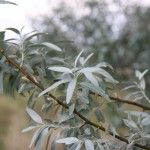Russian Olive
Elaeagnus angustifolia L.
Elaeagnaceae
Description
Russian Olive is an introduced, fast-growing, medium-sized tree that grows to be 10 to 25 feet or 3 to 7.6 meters tall. Its trunk and branches are armed with thorns that range from 1 to 2 inches or 2.5 to 5 cm in length and are usually reddish brown. Mature stems are smooth and become reddish brown with age. The new stem growth is covered with hairs which give it a silvery-gray color. Trunks can reach a circumference of up to 20 inches or 51 cm and are covered with dark gray, ridged bark. Its leaves are narrow and silvery with minute scales. They are 2 to 3 inches or 5 to 7.6 cm long, have smooth edges, and are alternately arranged. The top of the leaf is typically green-gray in color while the bottom of the leaf is silver. Russian Olive's flowers are yellow, bell-shaped, and clustered. The fruits are shaped like small olives and are silvery upon the first formation, but they will mature to a tan or brown color. Each fruit measures about 0.5 in or 1.25 cm in length and contains one seed.Habitat
Russian Olive is often used as an ornamental tree but will often invade low-lying pastures, fields, or waterways where it can become a serious weed problem. It prefers areas where the water table is near the soil’s surface such as riparian areas, floodplains, valley bottoms, irrigation ditches, springs, and sub-irrigated pastures or grasslands. It is native to southern Europe and to central and western Asia. In its native region, it occurs along coasts, in riparian areas, and in other moist habitats. Russian Olive has been cultivated for many uses including wildlife habitat and providing pollen for honeybees. Seeds are consumed by several bird and mammal species. Livestock may browse on young Russian Olive trees, but they are deterred once thorns are developed.Images
Plant Characteristics
Flower Color: Yellow
Seed Type: Fruit/Berry
Duration: Perennial
Stem Texture: Hairless/Smooth
Growth Habit: Shrub (Woody)
Leaf Shape
 : Simple with Pinnate or Parallel Venation
: Simple with Pinnate or Parallel Venation
Season: Warm
Distribution
 : 04 - Blackland Prairies, 08 - Rolling Plains, 09 - High Plains, 10 - Trans-Pecos
: 04 - Blackland Prairies, 08 - Rolling Plains, 09 - High Plains, 10 - Trans-Pecos
Distributions
Distribution refers to the ecological region in Texas that a plant has been found. You can also view a clickable map.
Collection: Brush and Weeds





